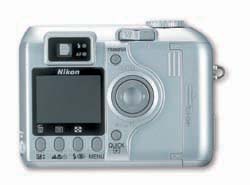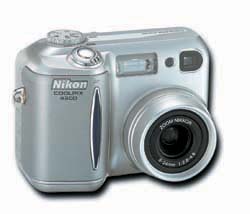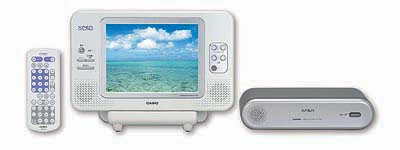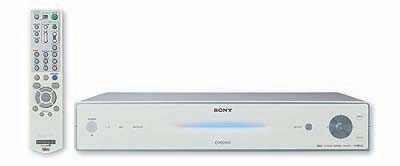 * Nikon COOLPIX4300 Source: Nikkei on Yahoo.com * Nikon COOLPIX4300 Source: Nikkei on Yahoo.com
The successor to the 3,000,000-pixel COOLPIX885 digicam, the COOLPIX4300 (JPY87,000) has -- wait for it -- 4 million pixels! "So why's it called the 4300?" I hear you ask. "Why not 4000?" Because it has a 4,130,000-pixel CCD of course.
Er, moving on....

The new Coolpix has a 3x optical zoom (and 4x digital) on its Zoom Nikkor Lens, with 35mm equivalents of 38-114mm and F2.8-4.9. The biggest picture the 4300 knocks out is 2,272x1,704 dots, which is enough for anyone, and they can be in either JPEG or TIFF format. Focal range is 30 cm to infinity and there's a macro mode to allow snapping from about 4 cm. The 4300 also has 12 "scenes" to reproduce all the right settings for particular conditions (e.g. at night). The images are stored on a Type I CompactFlash card and images can be sent to your PC at a single touch of the transfer button, which automatically starts up the Nikon View 5 software and effects the transfer.
The camera also features an ultra-high-speed snapping mode, allowing the taking of 30 pictures a second, but only at a resolution of 320x240 dots (it can also take 40 seconds of movies at this resolution, with output at 15 frames per second). AV output can be in both PAL and
NTSC. With the Olympus CAMEDIA C-4000 Zoom also fighting for the top spot in this category, things are getting real interesting.
More info: http://www.nikon-image.com/eng/PDF/index4300.htm
* J-Phone, Hutchison Unfazed by DoCoMo's 3G Outlook
Source: Reuters on ISPWorld.com, September 6
EXTRACT: Japan's J-Phone and Hong Kong-based Hutchison Whampoa said they would stand by plans to launch 3G mobile services this year, despite a sluggish start to the high-speed service by industry leader NTT DoCoMo. J-Phone, Japan's third-largest wireless carrier, said it still planned to launch its 3G service in December. The performance of DoCoMo's 3G service is of high interest to J-Phone, since it plans to launch a 3G service based on the same technological standard.
Hutchison Whampoa plans to launch its service in the United Kingdom and Italy in October, and said recently it aimed to sign up one million customers in each of those markets by the end of 2003 -- less than the 1.5 million target it had previously cited. "For Hutchison 3G, our plans remain unchanged. We will start to roll out phase one to approximately 5,000 friendly customers in October," a spokeswoman said.
More info: http://www.ispworld.com/Reuters/BreakingNews/090602_gt21.htm
...COMMENTARY: J-Phone has said that roaming will be a key part of its 3G strategy. "We've been saying we'll do global roaming with our 3G commercial service and this will be achieved in two ways specifically," says Matthew Nicholson of J-Phone's PR staff. One way is with so-called "plastic roaming," which is achieved by transferring a UIM/SIM card from a J-Phone W-CDMA handset to a GSM handset, thus transferring the subscriber's J-Phone account info to a handset that would then work in a GSM market. The other way is with dual mode technology handsets that will work under both W-CDMA and GSM network systems. He also adds that, at the time of their 3G commercial launch, J-Phone will have global roaming agreements in 50 countries.
 * Casio XFER XF-800 and XF-600
* Casio XFER XF-800 and XF-600
The world-famous calculator company has produced another totally mind-blowing, world-altering calculating machine in the XFER. Not really; actually it's a wireless LAN LCD television. Two of them, in fact, as the 336,960-pixel XF-800 has an eight-inch TFT LCD screen and the XF-600 model has a -- go on, guess!
The separate TV tuner unit uses MPEG-2 compression and sends the images to your LCD panel over the IEEE802.11b protocol at 2.4 GHz. Recharging on the unit is done by placing the thing back in its PDA-like stand after it's been going for about two hours, and there's even a wall-mounting unit included in the package.
But I've saved the best bit for last -- both television units are waterproof (as is the remote), and they have a signal range of 30m, so your lifelong dream of being able to sit up to your neck in a steam-filled ofuro (bath), sipping on an ice cold beer while watching the Monday Night Football game (minus the ads, I love you Gaora!) can now become a reality. Or is that dream just mine?
More info: www.casio.co.jp/release/2002/xf800_600.html
* NTT DoCoMo Introduced New Easy-to-Use F67liS Handset
Source: Company PR, September 2
NTT DoCoMo launched its F671iS handset in September 2002. The F671iS, an enhanced version of DoCoMo's popular F67li introduced in September 2001, offers a variety of new, convenient features, such as larger text and a function that reads aloud various content.
More info: http://www.nttdocomo.com
...COMMENTARY: Those of you who hit their 40th birthday anytime recently (... and we know who we are ;-)) will be interested in this baby. The 2.1-inch, 65,536-color TFT LCD screen offers text display that is some 65 percent larger than on previous models, making i-mode content, email messages, stored numbers and email addresses easier (not "easy") to read. In addition, instructions on how to perform operations, such as check call and mail logs, listen to messages and create mail are supported with graphics (arrows, et cetera). Interestingly, this handset provides a read back function involving, apparently, the voice readout of mail, call and message logs, time and day, date, stored numbers, operating menus, et cetera. This is the first time we've seen this functionality on the market here.
 * Sony CSV-E77 CoCoon
* Sony CSV-E77 CoCoon
This new CoCoon channel server from Sony (open price, but approx. JPY130,000) is a 160Gb broadband (or regular connection) hard disk recorder that allows users to record up to 100 hours (35 hours at highest MPEG2 quality) of programming based entirely on entering keywords. Launched under the mantra of "Personalize, Ubiquitous, Upgradeable," the CoCoon operates a bit like TiVo in Europe and the States, where you simply enter a keyword ("ramen," for example) and the machine will search through the electronic program listings for instances of the word. It can then record everything it finds so you'll never again be without the presence of the aforementioned noodles in your living room.
If you don't really trust your own little Robocop to find the Right Stuff, you can always go manual and find what you want to record yourself. Thanks to a built-in "preference algorithm," the machine will keep an eye on your likes and dislikes and proceed to suggest programs from the EPG that it thinks might appeal to you. Like a sort of personal shopper, only for television.
No doubt in recognition of humans' risible inability even to set a comparatively primitive VCR correctly, the onscreen user interface subdivides programming into nine categories. So, uh, if we, like, dig sports man, we just have to press the right button on the remote and we're, like, watching sports. Cool! And if we can't even make that elementary level of commitment to a single channel, the new interface presents a "multi-view," indicating which programs have already started, which are live broadcasts and so on. Kinda removes the joy of channel surfing, though.
The "ubiquitous" refers to a constant, virtual presence of the server, I think, because the CoCoon can connect via Ethernet or broadband and otherwise. So, whether you're in the study on your PC or roaming the streets, you can set the machine to record what you're missing.
More info: http://www.sony.jp/CorporateCruise/Press/200209/02-0904/
|
 * Nikon COOLPIX4300 Source: Nikkei on Yahoo.com
* Nikon COOLPIX4300 Source: Nikkei on Yahoo.com


 * Casio XFER XF-800 and XF-600
* Casio XFER XF-800 and XF-600  * Sony CSV-E77 CoCoon
* Sony CSV-E77 CoCoon


